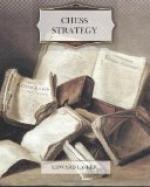In the following pages I give some instructive examples taken from tournament play. Step by step we will find how very important is the knowledge of the simple endings treated in the last chapter. We shall see that it is often necessary to consider many moves ahead to find the correct line, but that it is nearly always possible to foresee every consequence with unfailing certainty. Moreover, because of the reduction of forces there is no call to take very many variations into consideration. This explains why there is a tendency in modern master play to enforce the exchange of pieces, as soon as there is the slightest advantage sufficient to bring about one of the elementary end-game positions, in which the win can be forced.
1. From A game Teichmann-Blackburne (Berlin, 1897).
--------------------------------------- 8 | | | | | | | | | |---------------------------------------| 7 | | | | | | | #P | | |---------------------------------------| 6 | | | #P | | #K | #P | | #P | |---------------------------------------| 5 | | | | | | | | | |---------------------------------------| 4 | #P | | #P | | | | | ^P | |---------------------------------------| 3 | ^P | | ^P | | | | ^P | | |---------------------------------------| 2 | | | | | | ^P | ^K | | |---------------------------------------| 1 | | | | | | | | | --------------------------------------- A B C D E F G H
Diag. 82.
Black has an extra pawn on the Queen’s side. But as it is doubled, the material superiority is of no account. A perceptible advantage, however, lies in the fact that White cannot bring about a “forced move” position, as Black has the move P-QB4 in reserve. White has also an infinitesimal weakness on the King’s side, the Rook’s pawn having advanced two squares and being therefore an easy mark. This disadvantage soon becomes apparent.
1. P-B3 K-B4 2. K-B2 P-R4 3. K-Kt2 P-Kt4 4. K-R3 K-K4
With this move advantage is taken of one of White’s weaknesses. White must exchange pawns. If the King moves, Black captures, freeing B 5 for his King, from where he can later on get to K6 or Kt6. But after the exchange at Kt4, Black has the chance of obtaining a “distant passed pawn” on the Rook’s file.
5. PxP PxP 6. K-Kt2 K-B4 7. K-R2 K-B3
If Black were to play P-R5 at once, White would reply with 8. K-R3, and after PxP, 9. KxP. Black would have to give up the spare move P-B4, to gain the square at B5 for his King. The game then would be drawn after 10. K-Kt2! K-B5, 11. K-B2, because White maintains the opposition, and Black cannot get through at K6 or Kt6. Black therefore manoeuvres his King first in such a way that the square at his B4 is only reached when the White King is at Kt3.




